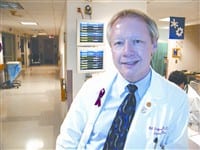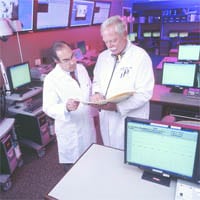‘Role’ Model ‘It Helps You Understand The Human Heart If You’ve Portrayed People’
Dr. William Swiggard isn’t sure if his work in medicine makes him a better actor or singer.
But he can say with a high degree of confidence that his work on various stages has made him a better doctor. In fact, his theatrical background inspired him to pursue a career in medicine.
Swiggard, who has performed on Broadway and played one of the lead roles in a touring company of the rock musical Hair, told The Healthcare News that his work in the theater and radio has provided valuable lessons in teamwork, preparation, and quality — all of which are easily transferred to his work with infectious diseases.
But there is more to it than that. “It helps you understand the human heart if you’ve portrayed people,” said Swiggard, adding that his efforts to portray different personalities on stage have given him higher levels of insight and compassion. “Having been an actor, I can say that understanding character means understanding patients.”
In a wide-ranging interview, Swiggard talked about how he combines the lessons of his two widely divergent disciplines. “There’s an old saying in the theater— an actor prepares,” he said. “That taught me how important it is to spend some time reviewing a patient’s chart before actually meeting with them.”
Furthermore, details are important. “Theater is a team affair,” he told The Healthcare News. “There are no small jobs in acting. You may be giving the performance of your life, but if your wig is on backwards, it’s all for naught. The same is true in medicine. It’s a team affair. It’s a team that takes care of the patient and makes them better.”
Part and Parcel
So how exactly does one make the transition from actor to physician? In fact, it was Swiggard’s background in the theater that led, both directly and indirectly, to his career in medicine.
He said that he saw dozens, even hundreds of his friends from the theater die of AIDS in the 1980s. He even refers to the disease as “my special enemy.”
The vagaries of life as an actor also played a part. In the early ‘80s, he found himself stranded in California. Finding himself typecast and unable to obtain any meaningful work as an actor, he took a “survival job” as a courier for a medical lab in Beverly Hills. “My only qualification for that job was that I had been a theater major,” he said.
Eventually, the firm made him a technician. About a year later, after returning to New York, he found that acting jobs continued to be scarce, pretty much non-existent. Once again, he found work as a medical technician, this time at a blood laboratory. In those days, he was mixing pure interferon for use across the street at the Sloan-Kettering Cancer Center. “This was before they started making artificial interferon,” he explained. “That job inspired me to the possibilities. I’m still inspired by that.”
Swiggard’s “hatred” for HIV/AIDS led him to study infectious diseases at Cornell University, where he entered a special program that resulted in both an M.D. and a Ph.D. He spent four years conducting research in an area that still fascinates him—the latency problem in HIV/AIDS.
The virus, Swiggard explained, “is like a mole or a sleeper agent. It stays in your body until energized by some stimulus. You must take drugs for life. If you stop, the virus comes back.”
He spends a day each week at the Holyoke Health Center, where he treats only HIV/AIDS patients. He is one of three doctors who are continuing the work of the late Dr. Gary Reiter. The Center has about 700 to 800 patients.
Swiggard, true to his belief that medicine, like theater, is a team affair, is quick to credit the rest of the team at the health center. “The nurse practitioners at the center are excellent. They are so good at taking care of the details that the doctors are free to concentrate on the medical decisions,” he said.
Interestingly, he says that great progress is being made not only in the fight against AIDS, but also against viruses in general. He calls 2003 a watershed year in the development of anti-viral drugs which, like antibiotics, are now being developed where none existed before.
Indeed, Swiggard told The Healthcare News that new drugs came on the market in 2003 that can cure about 55{06cf2b9696b159f874511d23dbc893eb1ac83014175ed30550cfff22781411e5} of the tougher strain of Hepatitis C and 90{06cf2b9696b159f874511d23dbc893eb1ac83014175ed30550cfff22781411e5} of the ‘easier’ strain.”
Swiggard does not confine himself only to HIV/AIDS. He is also a specialist in infectious diseases in general. As a result, part of his preparation is keeping current with recent trends in molecular medicine, an area where advances are occurring almost daily. “We are just beginning to understand disease at the genetic level,” he said. “The impact of the Human Genome Project will be enormous.”
Putting all of this new information together to fight disease presents challenges to the physician, something Swiggard welcomes. “I’m usually called in as a consulting physician in cases of infectious disease. It’s solving mysteries. I love my job because I solve mysteries. I wouldn’t trade it for the world.”
Curtain Call
Besides his duties at the hospital, Swiggard is also developing a private practice, Pioneer Valley Infectious Disease Associates of Northampton, in partnership with Dr. Joanne Levin. He spends roughly a half day at the hospital each day and a half day at the practice two or three times a week. The practice is part of Cooley Dickinson’s network of outpatient clinics.
With such a busy schedule, Swiggard’s acting and singing work these days is necessarily limited. He does confess to a desire to direct someday — preferably musicals — but “right now, medicine is not leaving a lot of time for that.”
Still, Swiggard is able to balance both aspects of his professional life and finds suitable rewards in both realms. It is said that art imitates life, and vice versa, and Swiggard’s career provides ample proof.



Comments are closed.